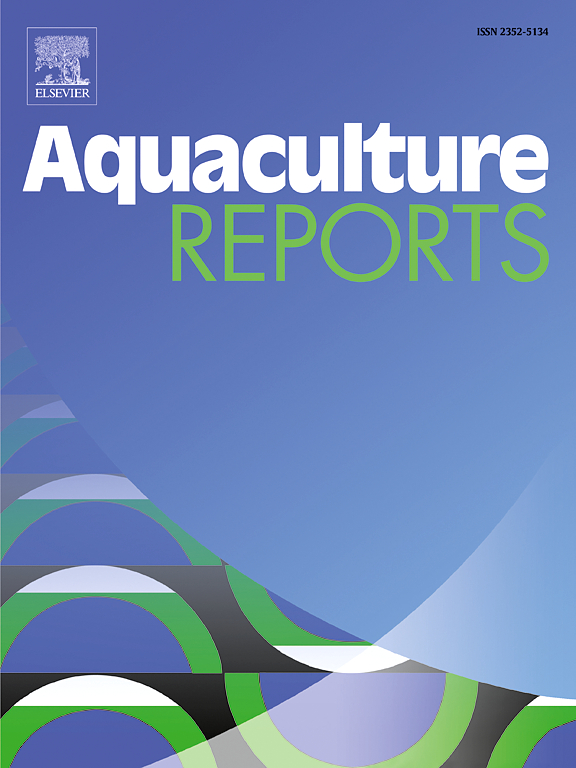饥饿对中华鳖肠道氧化应激、自噬、微生物群和组织学的影响
IF 3.2
2区 农林科学
Q1 FISHERIES
引用次数: 0
摘要
中华鳖(Pelodiscus sinensis)在其生命周期中经常遇到饥饿期,但饥饿对其肠道生理的影响尚不清楚。本研究探讨了饥饿对中华对虾肠道抗氧化状态、自噬、菌群和组织结构的影响。分别对海龟进行1、4、8、16和32天的饥饿处理(分别为S1、S4、S8、S16和S32)。组织学检查结果显示,随着饥饿时间的延长,肠绒毛逐渐缩短,肌层逐渐增厚。随着饥饿时间的延长,ROS和MDA含量逐渐升高。饥饿16 d和32 d后,SOD和GPx活性显著升高。透射电镜显示自噬体从S4开始存在,饥饿8天后观察到显著增加。自噬相关基因(atg5、atg12、p53、p62、lc3) mRNA表达量随饥饿时间延长而显著上调,而mtor1、s6k1表达量在S32组显著降低。此外,通过16S rRNA测序进行的微生物群分析表明,S1组和饥饿组之间存在明显的分离。饥饿导致肠道微生物多样性增加,Shannon指数升高,Simpson指数降低。在门水平上,厚壁菌门的丰度随着饥饿时间的延长而减少,而拟杆菌门和变形杆菌门的丰度则增加。Mantel试验显示,Proteobacteria丰度与ROS含量和p53表达水平呈显著正相关。综上所述,本研究提示饥饿诱导了中华对虾的氧化应激和自噬,改变了中华对虾肠道菌群结构和形态,为该物种的适应机制提供了有价值的见解。本文章由计算机程序翻译,如有差异,请以英文原文为准。
Starvation affects the intestinal oxidative stress, autophagy, microbiota and histology of Chinese soft-shelled turtle (Pelodiscus sinensis)
Chinese soft-shelled turtle (Pelodiscus sinensis) frequently encounters period of starvation during its life cycle, but the impact of starvation on its intestinal physiology remains unclear. This study investigated the effects of starvation on the antioxidant status, autophagy, microflora, and histological structure in the intestinal of P. sinensis. Turtles were subjected to starvation for 1, 4, 8, 16, and 32 days (referred to as S1, S4, S8, S16, and S32). The results of histological examination showed a progressive shortening of intestine villus and thickening of the muscle layer as starvation duration increased. The ROS and MDA contents showed a gradual increase with the prolonged starvation. The activities of SOD and GPx were significantly elevated after 16 and 32 days of starvation. Transmission electron microscopy revealed the presence of autophagosomes starting from S4, with a significant increase observed after 8 days of starvation. The mRNA expression levels of autophagy-related genes (atg5, atg12, p53, p62, and lc3) were significantly upregulated with the prolonged starvation, while the expressions of mtor1 and s6k1 were significantly decreased in S32 group. Moreover, microbiota analysis via 16S rRNA sequencing demonstrated a distinct separation between the S1 group and the starving groups. Starvation led to an increase in intestinal microbial diversity, as evidenced by an elevated Shannon index and a decreased Simpson index. At the phylum level, the abundance of Firmicutes decreased, whereas Bacteroidota and Proteobacteria increased with prolonged starvation. A Mantel test showed that the abundance of Proteobacteria was significantly positively correlated to ROS contents and the expression levels of p53. In conclusion, this study suggests that starvation induce the oxidative stress and autophagy, change the structure of microbiota and morphology in the gut of P. sinensis, and provides valuable insights to the adaptive mechanisms of this species.
求助全文
通过发布文献求助,成功后即可免费获取论文全文。
去求助
来源期刊

Aquaculture Reports
Agricultural and Biological Sciences-Animal Science and Zoology
CiteScore
5.90
自引率
8.10%
发文量
469
审稿时长
77 days
期刊介绍:
Aquaculture Reports will publish original research papers and reviews documenting outstanding science with a regional context and focus, answering the need for high quality information on novel species, systems and regions in emerging areas of aquaculture research and development, such as integrated multi-trophic aquaculture, urban aquaculture, ornamental, unfed aquaculture, offshore aquaculture and others. Papers having industry research as priority and encompassing product development research or current industry practice are encouraged.
 求助内容:
求助内容: 应助结果提醒方式:
应助结果提醒方式:


